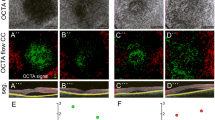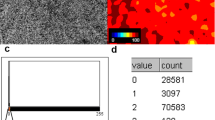Abstract
Purpose
To evaluate the choriocapillaris (CC) flow in central serous chorioretinopathy (CSC) and determine the relationship between CC flow void with the choroidal thickness (CT) and choroidal vascularity index (CVI).
Methods
Retrospective analysis of 20 patients with CSC (40 eyes, including unaffected fellow eyes) and 20 age- and sex-matched controls. After compensation with optical coherence tomography (OCT) en-face structural image, the CC flow void (%) was measured using the phansalkar threshold with a window radius of 3 and 15 pixels. The mean CC flow voids of acute CSC, recovered-acute CSC, unaffected fellow, and control eyes were compared by matched data analysis. A regression analysis was performed on the choroidal parameters (CT and CVI) and CC flow voids.
Results
The CC flow void had an increasing tendency in the following order: control, fellow, recovered-acute CSC, and acute CSC eyes. Acute/recovered comparison showed a significant P value (0.008) in the foveal lesion. Recovered/fellow and fellow/control presented significant P values regardless of location to fovea (all <0.05). There were significant positive correlations between CT and CC flow void (P < 0.05) in the acute CSC, recovered-acute CSC eyes.
Conclusion
The CC flow on OCT angiography decreased in acute CSC eyes, especially in the foveal lesion, with a published compensation method. The findings suggest that unmodulated choroidal blood flow contributed to partially reversible diminished CC flow.



Similar content being viewed by others
Change history
21 March 2022
A Correction to this paper has been published: https://doi.org/10.1007/s00417-022-05633-6
References
Kaye R, Chandra S, Sheth J et al (2020) Central serous chorioretinopathy: an update on risk factors, pathophysiology and imaging modalities. Prog Retin Eye Res 79:100865. https://doi.org/10.1016/j.preteyeres.2020.100865
Lauermann JL, Eter N, Alten F (2018) Optical coherence tomography angiography offers new insights into choriocapillaris perfusion. Ophthalmologica 239(2–3):74–84. https://doi.org/10.1159/000485261
Spaide RF (2016) Choriocapillaris flow features follow a power law distribution: implications for characterization and mechanisms of disease progression. Am J Ophthalmol 170:58–67. https://doi.org/10.1016/j.ajo.2016.07.023
Zhang Q, Zheng F, Motulsky EH et al (2018) A novel strategy for quantifying choriocapillaris flow voids using swept-source OCT angiography. Invest Ophthalmol Vis Sci 59(1):203–211. https://doi.org/10.1167/iovs.17-22953
Zhang A, Zhang Q, Wang RK (2015) Minimizing projection artifacts for accurate presentation of choroidal neovascularization in OCT micro-angiography. Biomed. Opt Express 6(10):4130–4143. https://doi.org/10.1364/BOE.6.004130
Chu Z, Cheng Y, Zhang Q et al (2020) Quantification of choriocapillaris with phansalkar local thresholding: pitfalls to avoid. Am J Ophthalmol 213:161–176. https://doi.org/10.1016/j.ajo.2020.02.003
Baltmr A, Lightman S, Tomkins-Netzer O (2014) Examining the choroid in ocular inflammation: a focus on enhanced depth imaging. J Ophthalmol 2014:459136. https://doi.org/10.1155/2014/459136
Agrawal R, Gupta P, Tan KA et al (2016) Choroidal vascularity index as a measure of vascular status of the choroid: measurements in healthy eyes from a population-based study. Sci Rep 12(6):21090. https://doi.org/10.1038/srep21090
Niblack W (1985) An introduction to digital image processing. Strandberg, Copenhagen
Burnasheva MA, Kulikov AN, Maltsev DS (2020) Artifact-free evaluation of choriocapillaris perfusion in central serous chorioretinopathy. Vision (Basel) 5(1):3. https://doi.org/10.3390/vision5010003
Rochepeau C, Kodjikian L, Garcia MA et al (2018) Optical coherence tomography angiography quantitative assessment of choriocapillaris blood flow in central serous chorioretinopathy. Am J Ophthalmol 194:26–34. https://doi.org/10.1016/j.ajo.2018.07.004
Cakir B, Reich M, Lang S et al (2019) OCT angiography of the choriocapillaris in central serous chorioretinopathy: a quantitative subgroup analysis. Ophthalmol Ther 8(1):75–86. https://doi.org/10.1007/s40123-018-0159-1
Reich M, Böhringer D, Cakir B et al (2019) Longitudinal analysis of the choriocapillaris using optical coherence tomography angiography reveals subretinal fluid as a substantial confounder in patients with acute central serous chorioretinopathy. Ophthalmol Ther 8(4):599–610. https://doi.org/10.1007/s40123-019-00218-9
Sonoda S, Sakamoto T, Kuroiwa N et al (2016) Structural changes of inner and outer choroid in central serous chorioretinopathy determined by optical coherence tomography. PLoS One 11(6):e0157190. https://doi.org/10.1371/journal.pone.0157190
Shinojima A, Fujita K, Mori R et al (2019) Investigation of the etiology of central serous chorioretinopathy using en-face optical coherence tomography and indocyanine green angiography. Ophthalmologica 236(2):100–107. https://doi.org/10.1159/000448342
Ledesma-Gil G, Fernández-Avellaneda P, Spaide RF (2021) Swept-source optical coherence tomography angiography imaging of the choriocapillaris. Retina 41(7):1373–1378. https://doi.org/10.1097/IAE.0000000000003109
Kishi S, Matsumoto H, Sonoda S et al (2018) Geographic filling delay of the choriocapillaris in the region of dilated asymmetric vortex veins in central serous chorioretinopathy. PLoS One 13(11):e0206646. https://doi.org/10.1371/journal.pone.0206646
Yun C, Huh J, Ahn SM et al (2019) Choriocapillaris flow features and choroidal vasculature in the fellow eyes of patients with acute central serous chorioretinopathy. Graefes Arch Clin Exp Ophthalmol 257(1):57–70. https://doi.org/10.1007/s00417-018-4179-2
Spaide RF (2020) Choroidal blood flow: review and potential explanation for the choroidal venous anatomy including the vortex vein system. Retina 40(10):1851–1864. https://doi.org/10.1097/IAE.0000000000002931
Spaide RF, Ryan EH Jr (2015) Loculation of fluid in the posterior choroid in eyes with central serous chorioretinopathy. Am J Ophthalmol 160(6):1211–1216. https://doi.org/10.1016/j.ajo.2015.08.018
Oh J, Baik DJ, Ahn J (2020) Inter-relationship between retinal and choroidal vasculatures using optical coherence tomography angiography in normal eyes. Eur J Ophthalmol 30(1):48–57. https://doi.org/10.1177/1120672118816225
Agrawal R, Chhablani J, Tan KA et al (2016) Choroidal vascularity index in central serous chorioretinopathy. Retina 36(9):1646–1651. https://doi.org/10.1097/IAE.0000000000001040
Kim RY, Chung DH, Kim M et al (2020) Use of choroidal vascularity index for choroidal structural evaluation in central serous chorioretinopathy with choroidal neovascularization. Retina 40(7):1395–1402. https://doi.org/10.1097/IAE.0000000000002585
Steinle JJ, Pierce JD, Clancy RL et al (2002) Increased ocular blood vessel numbers and sizes following chronic sympathectomy in rat. Exp Eye Res 74(6):761–768. https://doi.org/10.1006/exer.2002.1182
Almeida DRP, Zhang L, Chin EK et al (2015) Comparison of retinal and choriocapillaris thicknesses following sitting to supine transition in healthy individuals and patients with age-related macular degeneration. JAMA Ophthalmol 133(3):297–303. https://doi.org/10.1001/jamaophthalmol.2014.5168
Funding
This study was supported by the Basic Science Research Program through the National Research Foundation of Korea (NRF-2020R1F1A1074898).
Author information
Authors and Affiliations
Corresponding author
Ethics declarations
Competing interests
All authors certify that they have no affiliations with or involvement in any organization or entity with any financial interest (such as honoraria; educational grants; participation in speakers’ bureaus; membership, employment, consultancies, stock ownership, or other equity interest; and expert testimony or patent-licensing arrangements), or non-financial interest (such as personal or professional relationships, affiliations, knowledge or beliefs) in the subject matter or materials discussed in this manuscript.
Ethical approval
Owing to the retrospective nature of image analysis and anonymized data of this study, written informed consent procedures were exempted.
Additional information
Publisher’s note
Springer Nature remains neutral with regard to jurisdictional claims in published maps and institutional affiliations.
The original version of this article was revised. Table 3 is now corrected.
Rights and permissions
About this article
Cite this article
Hwang, BE., Kwak, JH., Kim, JY. et al. Quantitative analysis of choroidal blood flow parameters in optical coherence tomography and angiography in central serous chorioretinopathy. Graefes Arch Clin Exp Ophthalmol 260, 2111–2120 (2022). https://doi.org/10.1007/s00417-022-05588-8
Received:
Revised:
Accepted:
Published:
Issue Date:
DOI: https://doi.org/10.1007/s00417-022-05588-8




